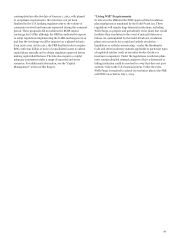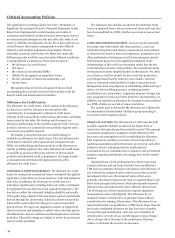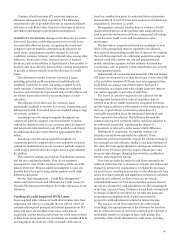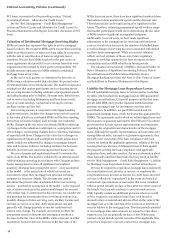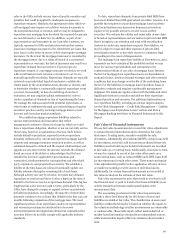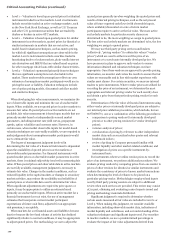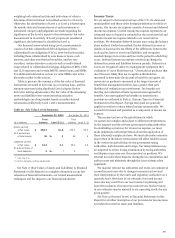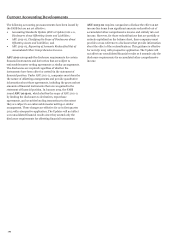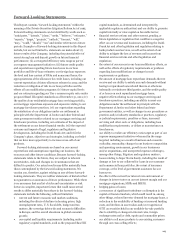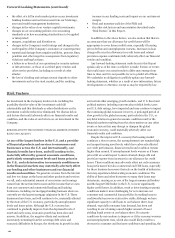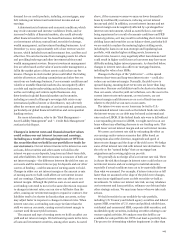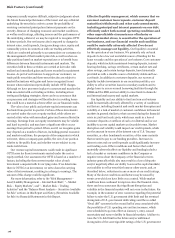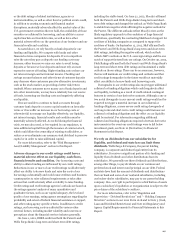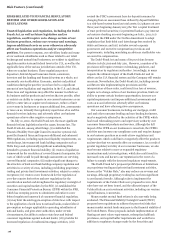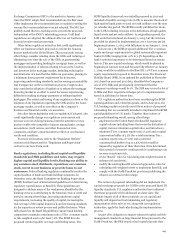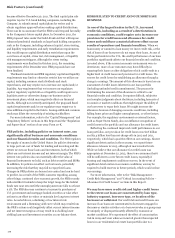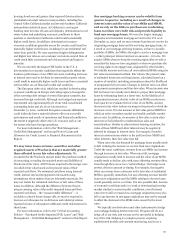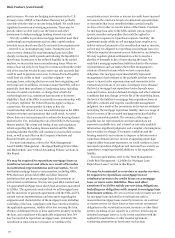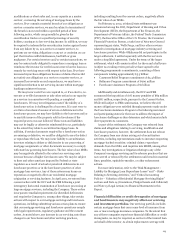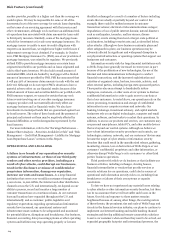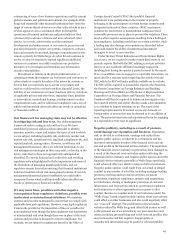Wells Fargo 2012 Annual Report Download - page 107
Download and view the complete annual report
Please find page 107 of the 2012 Wells Fargo annual report below. You can navigate through the pages in the report by either clicking on the pages listed below, or by using the keyword search tool below to find specific information within the annual report.demand for our credit products, including our mortgages, may
fall, reducing our interest and noninterest income and our
earnings.
A deterioration in business and economic conditions, which
may erode consumer and investor confidence levels, and/or
increased volatility of financial markets, also could adversely
affect financial results for our fee-based businesses, including
our investment advisory, mutual fund, securities brokerage,
wealth management, and investment banking businesses. As of
December 31, 2012, approximately 22% of our revenue was fee
income, which included trust and investment fees, card fees and
other fees. We earn fee income from managing assets for others
and providing brokerage and other investment advisory and
wealth management services. Because investment management
fees are often based on the value of assets under management, a
fall in the market prices of those assets could reduce our fee
income. Changes in stock market prices could affect the trading
activity of investors, reducing commissions and other fees we
earn from our brokerage business. Poor economic conditions and
volatile or unstable financial markets also can negatively affect
our debt and equity underwriting and advisory businesses, as
well as our trading and venture capital businesses. Any
deterioration in global financial markets and economies,
including as a result of Europe’s sovereign debt crisis or any
international political unrest or disturbances, may adversely
affect the revenues and earnings of our international operations,
particularly our global financial institution and correspondent
banking services.
For more information, refer to the “Risk Management –
Asset/Liability Management” and “– Credit Risk Management”
sections in this Report.
Changes in interest rates and financial market values
could reduce our net interest income and earnings,
including as a result of recognizing losses or OTTI on
the securities that we hold in our portfolio or trade for
our customers. Our net interest income is the interest we earn
on loans, debt securities and other assets we hold less the
interest we pay on our deposits, long-term and short-term debt,
and other liabilities. Net interest income is a measure of both our
net interest margin – the difference between the yield we earn on
our assets and the interest rate we pay for deposits and our other
sources of funding – and the amount of earning assets we hold.
Changes in either our net interest margin or the amount or mix
of earning assets we hold could affect our net interest income
and our earnings. Changes in interest rates can affect our net
interest margin. Although the yield we earn on our assets and
our funding costs tend to move in the same direction in response
to changes in interest rates, one can rise or fall faster than the
other, causing our net interest margin to expand or contract. Our
liabilities tend to be shorter in duration than our assets, so they
may adjust faster in response to changes in interest rates. When
interest rates rise, our funding costs may rise faster than the
yield we earn on our assets, causing our net interest margin to
contract until the asset yield increases.
The amount and type of earning assets we hold can affect our
yield and net interest margin. We hold earning assets in the form
of loans and investment securities, among other assets. As noted
above, if the economy worsens we may see lower demand for
loans by creditworthy customers, reducing our net interest
income and yield. In addition, our net interest income and net
interest margin can be negatively affected by a prolonged low
interest rate environment, which as noted below is currently
being experienced as a result of economic conditions and FRB
monetary policies, as it may result in us holding short-term lower
yielding loans and securities on our balance sheet, particularly if
we are unable to replace the maturing higher yielding assets,
including the loans in our non-strategic and liquidating loan
portfolio, with similar higher yielding assets. Increases in
interest rates, however, may negatively affect loan demand and
could result in higher credit losses as borrowers may have more
difficulty making higher interest payments. As described below,
changes in interest rates also affect our mortgage business,
including the value of our MSRs.
Changes in the slope of the “yield curve” – or the spread
between short-term and long-term interest rates – could also
reduce our net interest margin. Normally, the yield curve is
upward sloping, meaning short-term rates are lower than long-
term rates. Because our liabilities tend to be shorter in duration
than our assets, when the yield curve flattens, as is the case in the
current interest rate environment, or even inverts, our net
interest margin could decrease as our cost of funds increases
relative to the yield we can earn on our assets.
The interest we earn on our loans may be tied to U.S.-
denominated interest rates such as the federal funds rate while
the interest we pay on our debt may be based on international
rates such as LIBOR. If the federal funds rate were to fall without
a corresponding decrease in LIBOR, we might earn less on our
loans without any offsetting decrease in our funding costs. This
could lower our net interest margin and our net interest income.
We assess our interest rate risk by estimating the effect on
our earnings under various scenarios that differ based on
assumptions about the direction, magnitude and speed of
interest rate changes and the slope of the yield curve. We hedge
some of that interest rate risk with interest rate derivatives. We
also rely on the “natural hedge” that our mortgage loan
originations and servicing rights can provide.
We generally do not hedge all of our interest rate risk. There
is always the risk that changes in interest rates could reduce our
net interest income and our earnings in material amounts,
especially if actual conditions turn out to be materially different
than what we assumed. For example, if interest rates rise or fall
faster than we assumed or the slope of the yield curve changes,
we may incur significant losses on debt securities we hold as
investments. To reduce our interest rate risk, we may rebalance
our investment and loan portfolios, refinance our debt and take
other strategic actions. We may incur losses when we take such
actions.
We hold securities in our available-for-sale portfolio,
including U.S. Treasury and federal agency securities and federal
agency MBS, securities of U.S. states and political subdivisions,
residential and commercial MBS, corporate debt securities, and
marketable equity securities, including securities relating to our
venture capital activities. We analyze securities held in our
available-for-sale portfolio for OTTI on at least a quarterly basis.
The process for determining whether impairment is other than
105


